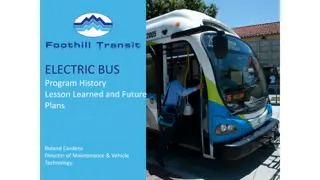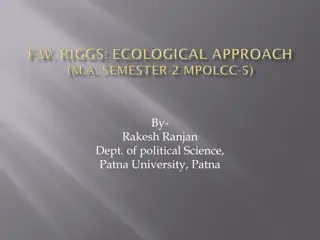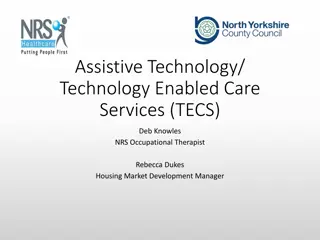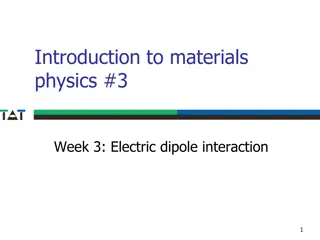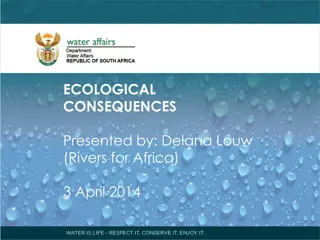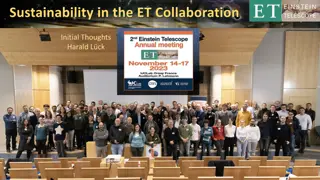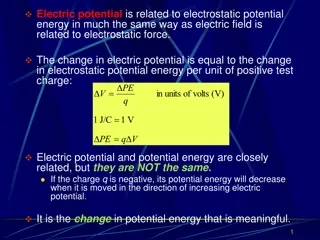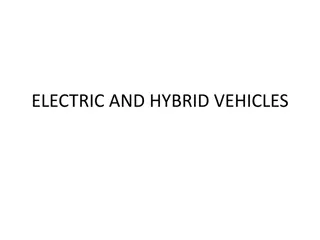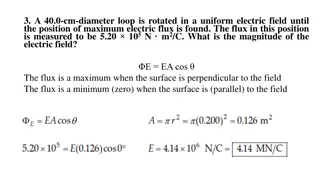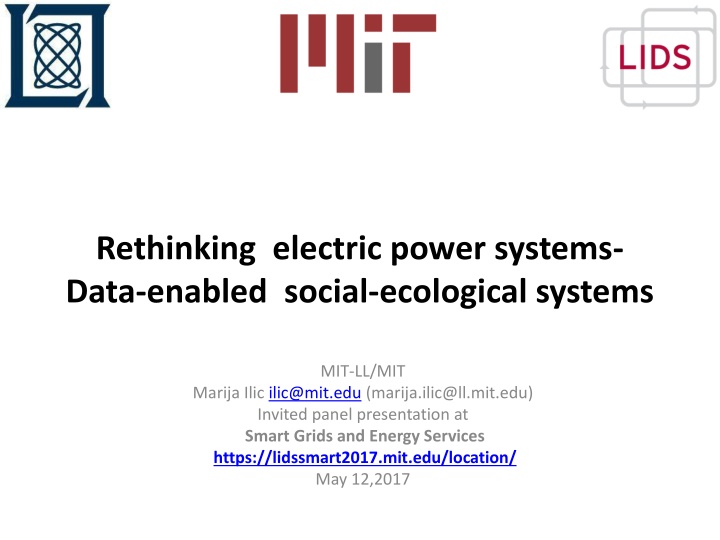
Rethinking electric power systems- Data-enabled social-ecological systems
Explores the role of data-enabled smart grids in shaping sustainable energy services within social-ecological systems. Discusses key attributes, decision-making processes, and challenges in paradigm shifts. Highlights the importance of collaboration and innovative modeling for transforming electric power systems.
Download Presentation

Please find below an Image/Link to download the presentation.
The content on the website is provided AS IS for your information and personal use only. It may not be sold, licensed, or shared on other websites without obtaining consent from the author. If you encounter any issues during the download, it is possible that the publisher has removed the file from their server.
You are allowed to download the files provided on this website for personal or commercial use, subject to the condition that they are used lawfully. All files are the property of their respective owners.
The content on the website is provided AS IS for your information and personal use only. It may not be sold, licensed, or shared on other websites without obtaining consent from the author.
E N D
Presentation Transcript
Rethinking electric power systems- Data-enabled social-ecological systems MIT-LL/MIT Marija Ilic ilic@mit.edu (marija.ilic@ll.mit.edu) Invited panel presentation at Smart Grids and Energy Services https://lidssmart2017.mit.edu/location/ May 12,2017
Outline General notion of smart grid as an enabler of sustainable electric energy services in social-ecological systems (SES); key role of data-enabling The key role in solving major societal problems The challenge and opportunity abstraction for novel modeling, simulation and design principles to support paradigm change Difficult questions and possible solutions Huge challenge and opportunity novel simulators for rapid demonstration of paradigm changes and their implications (key need for collaborations) An example of real-world complex grid (extra slides)
Smart gridenabler of sustainable energy services General social-ecological system (SES) [1] Smart grid enabler of social-ecological energy systems [2]
Abstraction-interacting decision makers DIVERSE DECISION MAKERS USERS; ISO; UTILITIES; LSEs; NODES; EVs; OTHER DISTIRBUTED ENERGY RESOURCES (DERs) Communicated Data Structure Learned Data Structure Processed to get bid functions and sent to EVLSE Charge requirements sent by driver simulation EV Module Prices over a horizon sent by price-forecaster SOC Sent to driver simulator EXAMPLE OF AN EV AS A DECISION MAKER [3] GENERAL (ABSTRACT) REPRESENTATION OF AN INTERACTIVE SMART DECISION MAKER
Smart grids--- modeling, analysis and design principles [2,6]
The key role of smart grids in solving societal problems Ten key attributes determining sustainability of a complex SES [1] size of resource; predictability of system dynamics; resource unit mobility; number of users; leadership; norms/social capital; knowledge of the SES; importance of resources to users; collective choice rules. Conjecture (Ilic, 2017) All these attributes can and should be shaped through data enabling (embedded intelligence into decision makers, and information exchange between them)
Avoiding tragedy of the commons WHEN MANAGING RESOURCES EXCEEDS THE PERCEIVED COSTS OF INVESTING IN BETTER RULES AND NORMS FOR MOST OF USERS AND THEIR LEADERS; THE PROBABILITY OF SELF-ORGANIZING IS HIGH [1] Several institutional economists suggest: IT plays fundamental role in managing tragedy of the commons problem---non-sustainable electric energy services (an example of tragedy of the commons problem)
Challenge in engaging consumers Nobody knows their monthly electricity bill (too cheap, or socialized? flat rates for non-differentiated services) Theoretically impossible to prove to the end user that they are using green power (unless at their home); no mechanisms to implement choice Utilities do not know users preferences; users generally inelastic (repeat INDEX [4] as ELDEX [5]; data gathering/analysis critical) Short-term vs. long-term efficiency solutions (easier to by new refrigerator/insulate than to make the house smart) Value provided by utilities/LSEs to consumers needs re- thinking (aggregation to reduce need for expensive hardware)
Difficult academic questions Abstraction of the complex problem for analysis and design. Aligning multiple objectives--physical, economic, financial and environmental performance (integration of technologies and systems solutions at value) [6] Aligning sub-objectives of distributed decision makers and system-level objectives Methods for on-line flexible system management (beyond worst case approaches to socialized reliability) Challenges different across temporal and spatial scales -potentially unstable dynamics in small grids with persistent multi-scale disturbances (fundamental limit to using clean resources) (tightly coupled, nonlinear modules--control design/standardization needed) -lack of market signals for managing dynamics and uncertainties at value
The role of academic research Educate starting from existing problems and using abstractions/methods to be used in the future (identify exciting open problems and solutions) Provide thought leadership to the industry toward changing industry paradigm from grid-centric to consumer-centric and the role of data-enabled approaches (beyond hardware) Pose key problems of designing cyber-physical systems in support of sustainable electric energy services as large IDSS problems Lead the way in modeling and analysis/design principles required; build scalable simulators/visualization in support of new pradigms Work toward generalized abstractions of the problem which can be posed and related (translated) in context of today s industry practice build on existing SCADA and not start from scratch (for example) Huge challenges and opportunities to help industry/have impact
Huge opportunitynovel simulators for rapid analysis and design using systematic abstractions Collaborations key: NSF-JST-DFG Microgrid Controller CMU-MIT-MIT/LL SGRS Platform Simulated Energy storage system Simulated 1 MVA Genset Simulated 4 MVA Genset Simulated Solar PV system Simulated Induction motors DAMPS Implementations Simulated distribution network Simulated Sheriff (CAMPS implementation) Simulated Banshee (CAMPS [7,8] implementation) Centralized Simulations (CAMPS) Multi-core distributed Simulations (DAMPS)
Publications [1] Elinor Ostrom, et al, A General Framework for Analyzing Sustainability of social-Ecological Systems, Science 325, 419 (2009) [2] Ilic, M., Dynamic Monitoring and Decision Systems for Sustainable Electric Energy, Proc of the IEEE, Jan 2011 [3] J.Donadee, M.Ilic, Stochastic optimization of grid-to-vehicle frequency regulation capacity bids , IEEE Trans. on Smart Grids, Feb 2014. [4] R.Edell, P. Varaiya, Providing internet access: what we learn from INDEX , IEEE Network, Sept/Oct 1999. [5] Model-based protocols for the changing electric power industry, PSCC, Sevilla, Spain, June 2002. [6] Ilic, Marija, Toward a Unified Modeling and Control for Sustainable and Resilient Electric Energy Systems, Foundations and Trends in Electric Energy Systems, Vol. 1, No. 1 (2016) 1 14, DOI 10.1561/3100000002 [7] M. R. Wagner, K. Bachovchin, and M. Ilic, Computer architecture and multi time-scale implementations for smart grid in a room simulator, IFAC-PapersOnLine, vol. 48, no. 30, pp. 233 238, 2015 [8] ] Ilic, M, et al, A Decision Making Framework and Simulator for Sustainable Electric Energy Systems, The IEEE Trans. On Sustainable Energy, TSTE-00011-2010, January 2011. 12
Complex electric power system Example of Sheriff distribution system [MIT LL repository] CRITICAL LOADS PRIORITY LOADS Interruptible LOADS
Load Profile Minimum Loading Real Power Absolute Demand (in MW) Demand 0.99 36.14 1.01 37.15 0.73 26.70 2.73 Maximum Loading Real Power Absolute Demand (in MW) Demand 3.90 50.39 1.18 15.30 2.65 34.31 7.73 Reactive Power Absolute Demand (in MW) 0.44 0.21 0.11 0.76 Reactive Power Absolute Demand (in MW) 1.93 0.81 0.47 3.21 Type of Load % of total % of total Demand 57.33 27.79 14.88 % of total % of total Demand Priority Critical Interruptible Total 60.25 25.21 14.54 Interruptible loads constitute 26 35% of total real power demand at any time instant. This defines the synthetic reserve capability of this grid We replace variable portion of interruptible loads with fleet of electric vehicles. Each EV is rated as with 95% efficiency
Interdependencies with transportation EV participation CRITICAL LOADS PRIORITY LOADS Interruptible LOADS
Sheriff as a single NODE Introduction of EVs Bus No. Mean value of Inflexible load (in MW) Aggregate EVLSE power demand (in MW) No. of EVs 12 13 17 18 0.145 0.205 0.156 0.221 0.727 0.784 0.724 0.09 0.325 1.923 206 191 24 86 507 Total
Utility interconnected to several Network Optimized Distribution Energy Systems (NODES) UTILITY BUS NODE 2 NODE 1 SHERIFF GRID BANSHEE GRID
Information flows to NODES and from NODES to utility markets No fast system-wide information exchange at present


